As I mentioned, I made the focal on the 8th of February; the cloisonne, however, quite likely goes back over thirty years—I evidently purchased four or five beads, used one in a project I'm pretty sure I made before I got married[1] , leaving me with the three I put into this necklace.[2] Compared to what's typically available, they're splendid, with transparent enameling and some nice, shaded colour gradations.
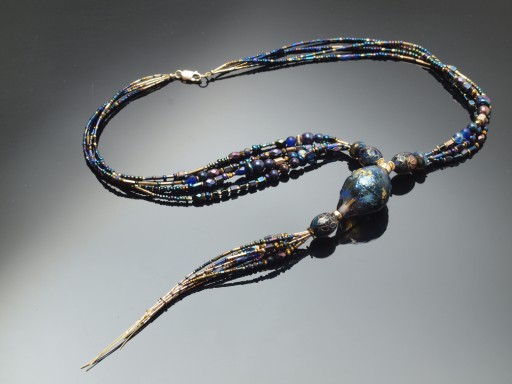
Gold-coloured beadalon, lampwork, czech and seed beads, many iridized; gold-filled findings and beads, also plated; sterling crimps, cloisonne. 2018. This image combines two exposures and other relatively minor photo editing.
I figure I've got 10—15, if I'm lucky—years of stringing left in me, before my joints, fine motor control and eyesight make this sort of fine work impractical, and frankly I don't really want to be one of those pathetic crafters whose best beads, whether organized neatly or slopped about in drawers—ends up on an auction block after I'm dead. Much better to use as many as I can (while acknowledging that one has to have a certain level of quantity to make the sort of designs I do practical.) The focal is not perfect but it's pretty, and the cloisonne matched. Yay! Yes! Time to use them!
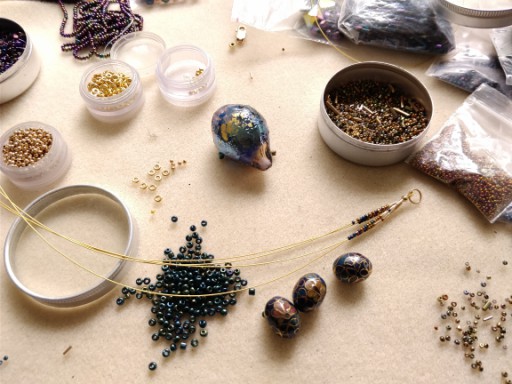
We begin. Note the lack of relative chaos. To have as little beadalon as possible showing, and as graceful a transition from the clasp, I start with ‘liquid’ gold-filled beads.
The same with the gold coloured beadalon. It goes. It's been sitting around. I can buy more. Let's try it!
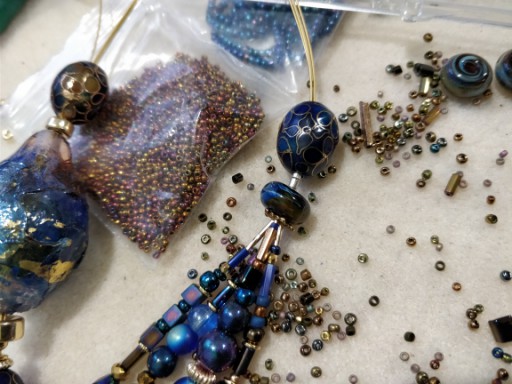
The little spacers, by Frances, are boro, and have some nice, subtle silver-glass effects going on, that also co-ordinate well with the focal and the cloisonne.[3]
Which is not to say that I didn't have stuff I wanted to use up. Every once in awhile, I decide, because of changing focus (semiprecious to glass/lampwork, frex) that it's time to reorganize my beads, which are scattered amongst, uhhhhh, four, no five! levels of organization. This usually reveals beads that have been hanging around forever, that should either be a) used b) sold or c) given away. I have gotten rid of some of my beads using the latter two methods, but my usual MO is to try and figure out something.
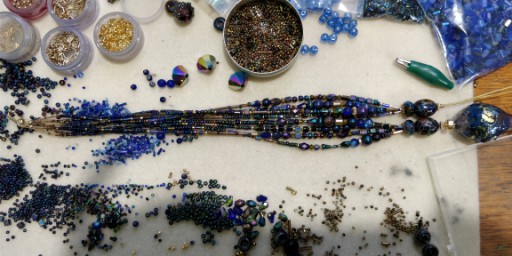
When stringing bilaterally symmetrical pieces like this one, it's critically important to line up the sides and make sure they match: the quickest and most robust method I know for catching errors. —I had nearly completed the piece and was trying it on before I realized I'd left out one of the trim beads in the transitional region between the multi-strands and the focal. Fortunately, I didn't have to do a ton of restringing.
The iridized or vitraile or ‘peacock feather’ czech and seed beads are a good example. Back when I did shows and carried a ‘travelling’ case of beads with me, I had one 18 compartment box full of assorted czech round and faceted iridized beads. I mostly quit doing shows after my second child was born, and given that same child has now graduated college & has started hir first real job, that was a bit ago. Or, put it another way: the plastic boxes are crazing and falling apart from UV exposure—indoors!
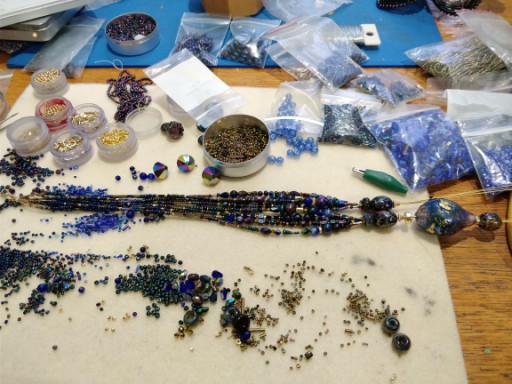
Another view in progress, showing more of the beads used in stringing the piece. The three large iridescent 5301s were trialled, but ultimately didn't work with the design.
They're kind of gaudy beads, and not really something I can do myself in glass.[4] But I thought they would combine well with the focal, and make a nice necklace in the style of some of my other, relatively finely-stranded pieces.
The biggest challenge has to do with the way the tassel is shaped. This problem has occupied me, on and off, for over a decade. The ultimate goal is to have the strands move independently, graduate from larger to smaller beads, yet come to a point, like a nicely shaped round sable brush.
I'm still refining that.
[1]Or shortly thereafter—but sometime in the late 80s, I presume
[2]I have a vague memory of another project using these beads, and I would've been more likely to purchase 5 than 4. But that wisp is all I can bring to the table.
[3]The silvery effect between Fran's boro spacer and the cloisonne comes from my sliding all the beadalon into several large white basemetal crimps, I technique I call ‘double stringing’, which I usually do to improve the way the piece lays.
[4]This is now not so: once upon a time, your only real option, so I was given to understand, was a very toxic spray. Now, Double Helix's Arke makes a very creditable, if pricey way to get this vivid finish—and so once again, just on the verge of using something up, I've learned how to successfully incorporate it. And that's without even discussing the french beaded flowers...
Unless otherwise noted, text, image and objects depicted therein copyright 1996--present sylvus tarn.
Sylvus Tarn